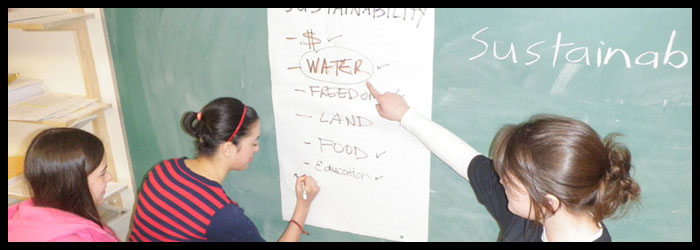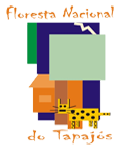

Over the course of the Amazon Expedition, i2P Education will be posting Student Exercises. These are Biodiversity related exercises that students and teachers can engage in, and relate back to a fundamental principle or point of interest about biodiversity.
Check back every Monday and Thursday for a new student exercise.
Exercise 12:
Haiti was once a marvel of biodiversity. A Polish officer serving in the French expeditionary force commented in 1803:
"If the country were at peace, it would surpass nearly all Europe in the beauty of its crops and forests... [The officers] could not contain their admiration at the sight of the diverse and innumerable plants so different from those of Europe."
(see Biodiversity and Haiti).
Unfortunately, the lauded biodiversity that once existed in Haiti has been nearly wiped out; 97% of the forest cover has been destroyed, and a 1985 report from USAID cautioned:
"Few countries in the world face a more serious threat to their own survival from environmental catastrophe than Haiti. Overpopulated, its resources overexploited and with trends towards further environmental deterioration everywhere, the country should brace itself for widespread famine, social upheaval and the potential breakdown of its socioeconomic and political structures."
Can you think of some of the ways in which Haiti could begin to protect or even recover its vast forests and biodiversity? The Haitian government has put together a plan to do just this. Compare your ideas against theirs:
Haiti National Biodiversity Strategy and Action Plan
Exercise 11:
The first genetically modified food to end up on supermarket shelves was the Flavr Savr tomato produced by a company called Calgene.
The following website contains a list of genetically modified foods. How much of what you are eating has likely come from a genetically modified source?
see: GMO
For more details see: Module 7
Exercise 10:
Please consider what characteristics of a plant or animal make it more profitable to grow/raise for widespread food distribution and consumption? Do these characteristics always align with what is best for humans to eat?
For more details see: Module 7
Exercise 9:
According to the International Union for the Conservation of Nature (IUCN) 32% of all species of plants and animals they have assessed (17,291 species out of the 47,677 species) are currently threatened with extinction (see: IUCN). Since 1948 the IUCN has kept the Redlist, a comprehensive, global, and objective list of the conservation status of plant and animal species
See: redlist
For more details see: Module 8
Exercise 8:
The combination of population explosion and increased consumption is driving the rapid degradation of the Earthís biodiversity.
In what manner do your day to day activities influence the degradation of biodiversity? Please consider:
- the food you eat
- the transportation you use
- the size of your family
- the size of your house
- how you heat your home
- your leisure activities
For more details see: Module 9
Exercise 7:
Human beings like all other organismsí benefit from the diversity of life on earth. These benefits, called ecosystem services (see: ecosystem services), provide humans with the core necessities of life:
- The capture of the suns energy
- The creation of oxygen
- The provision of food and medicines
- The purification of air and water
- The regulation of climate
The ecosystems services that the natural world provides to human beings are finite. The rate at which we are consuming these services is increasing rapidly, particularly in the past one hundred years.
Consider how your grandparents lived. Can you identify how your current lifestyle results in the consumption of more ecosystem services than that of your grandparents did?
For more details see: Module 9
Exercise 6:
For a fascinating review of how the fossil record has revealed the growth of biodiversity and impact of periodic extinctions
see: extinction
for more details see: Module 2
Exercise 5:
Artificial Selection
Read about how the Chihuahua, Pekinese, Great Dane and Saint Bernard all arose from the same species, the Grey Wolf that was first domesticated about 15,000 years ago.
See: how new species form
For more details see: Module 2
Exercise 4:
Haiti: A Disaster of Declining Biodiversity
Haiti was once a marvel of biodiversity. A Polish officer serving in the French expeditionary force commented in 1803:
"If the country were at peace, it would surpass nearly all Europe in the beauty of its crops and forests... [The officers] could not contain their admiration at the sight of the diverse and innumerable plants so different from those of Europe." (see Biodiversity and Haiti)."
Unfortunately, the lauded biodiversity that once existed in Haiti has been nearly wiped out; 97% of the forest cover has been destroyed, and a 1985 report from USAID cautioned:
"Few countries in the world face a more serious threat to their own survival from environmental catastrophe than Haiti. Overpopulated, its resources overexploited and with trends towards further environmental deterioration everywhere, the country should brace itself for widespread famine, social upheaval and the potential breakdown of its socioeconomic and political structures."
The "further environmental deterioration" continues to this day, with staggering effects. The vast majority of springs, streams and rivers in Haiti have become horribly contaminated. 15,000 acres of arable land are destroyed each year by unsustainable farming practices, and many of the species that once inhabited the island have become extinct. The lack of forests and root systems means the soil is susceptible to large-scale erosion. Disastrous, and sometimes fatal, landslides are common.
The effects on the men, women and children living in Haiti have been disastrous as well. Haiti is the poorest country in the Western hemisphere with 65% of its population living on less than $1 per day. General health is atrocious. 90% of children are chronically infected with intestinal parasites most commonly caused by contaminated drinking water and malnutrition, and Haiti has the highest rates of infant (under-five years old) and maternal mortality in the Western hemisphere. The biodiversity of forests in Haiti once provided clean water and limited the spread of disease. Today, Haitiís continued destruction of forest and indigenous wildlife only exacerbates the vicious cycle of poverty and disease.
Can you think of some of the ways in which Haiti could begin to protect or even recover its vast forests and biodiversity? The Haitian government has put together a plan to do just this. Compare your ideas against theirs:
Haiti National Biodiversity Strategy and Action Plan
For more details see: Module 5
Exercise 3:
Researchers are finding physical changes to the cod in the North Atlantic - a rapid evolutionary response to new environmental conditions caused by the practices of overfishing and bottom trawling. Think of some of the ways in which the physical appearance of cod may change to adapt to these new challenges. Compare these to what researchers are finding in their own studies:
See The Downturn of the Atlantic Cod and Angling for Evolutionary Answers.
For more details see: Module 5
Exercise 2:
Did you know there may be as many as 70 indigenous groups still living in the depths of the Amazon rainforest that have never had contact with the outside world? That means they would have no knowledge of cars, or planes, or the television. These groups are called 'uncontacted tribes'.
Please watch the remarkable video on uncontacted tribes of the Amazon at: Lost Tribes. The video runs 2 minutes and 52 seconds.
For more details see: Module - Introduction
Exercise 1:
The i2P team is heading to Brazil, the largest country in South America. Brazil is so large it borders on almost every other country on the continent. How many countries in South America do not border on Brazil? Please consider the following map: South America.
Hint: there are some very small countries, and some are islands. For list of countries see: South American Countries
For more details see: Module - Introduction






